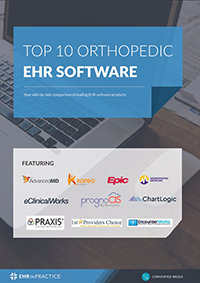Three requirements for an orthopedics EHR
For orthopedic practices, selecting an EHR with the right set of features is important not only to ensure that quality and efficiency of care is maintained but also to avoid the growing problem of EHR burnout and EHR associated stress among several medical practice areas. A study published in the December 5, 2018 issue of the Journal of the American Medical Informatics Association (JAMIA) examined the prevalence of HIT-related stress reported that among the 15 most commonly reported specialties. The specialty practice areas that displayed the highest prevalence of HIT-related stress was orthopedic surgery (86.5%). Orthopedists who were surveyed mentioned that more intuitive user interfaces; harmonized quality metrics, and automated data collection that can pull from free text instead of fields and checkboxes could improve workflows in their practices and thus reduce stress.
Based on the information provided in the survey referenced above and general considerations in EHR selection for orthopedic practices can identify three requirements, orthopedic practices should consider when selecting an orthopedics EHR.
Three requirements for orthopedics EHR
The three requirements reviewed here mirror the concerns raised in the JAMIA study referenced above. The first two address features that improve workflows by reducing the need for extraneous clicking and data entry, the third deals with features that can take the headache out of complying with quality of care measures mandated by CMS.
Orthopedics specific templates for notes
Orthopedic-specific templates and flow sheets allow for customizable content and the ability to tailor workflows accordingly. Most important to time-pressed clinicians a system should allow a clinician to create patient notes without clicking boxes and pull-down menus. Instead of notes, templates should feature a complete patient note on a single screen to avoid toggling back and forth.
Customizable treatment plans
Orthopedic treatment plans should be customizable to allow them to fit into existing workflows or make workflows more efficient without extensive customization and content development. In line to be aligned to be tailoring their system to how orthopedic practices work daily. For example, some orthopedic EHRs contains a knowledge base that enables the creation of customizable “one-click” treatment plans, orders for surgery and therapy, prescriptions, patient education, and referral letters, and much more.
The features outlined above should be viewed as a useful, starting point for requirements gathering when selecting an orthopedic EHR. However, what an orthopedic practice will need can vary depending on whether specialty orthopedic services are being offered or the practices patient-base is unique.
Quality measurement and benchmarking
Orthopedic practices can benefit from an EHR that can provide practices with a MIPS scorecard, real-time peer benchmarking, automated reporting allowing providers to track their performance under the merit-based reimbursement program through CMS. Under MACRA’s pay-for-performance program, practices should consider quality measurement, tracking, and reporting features to improve quality care and to maximize reimbursement.
What an orthopedic practice will need can vary depending on whether specialty orthopedic services are being offered or the characteristics of the practice’s patient population. As such an orthopedics EHR should, at a minimum offer the features mentioned above as a starting point.
Free white paper

Top 10 Orthopedic EHR Comparison
Compare the top orthopedic EHR systems on offer in our top 10 comparison

Featured white papers
Related articles
-

EHR requirements and key features: your complete guide
Our extended guide to EHR requirements - everything you need to know and more on the subject
-

What successful EHR requirements gathering looks like
How to get the most out of your EHR requirements gathering process
-

The top four EHR requirements every practice should have




